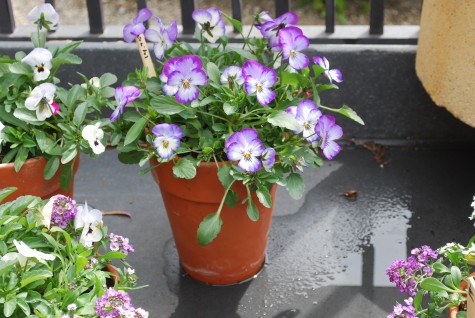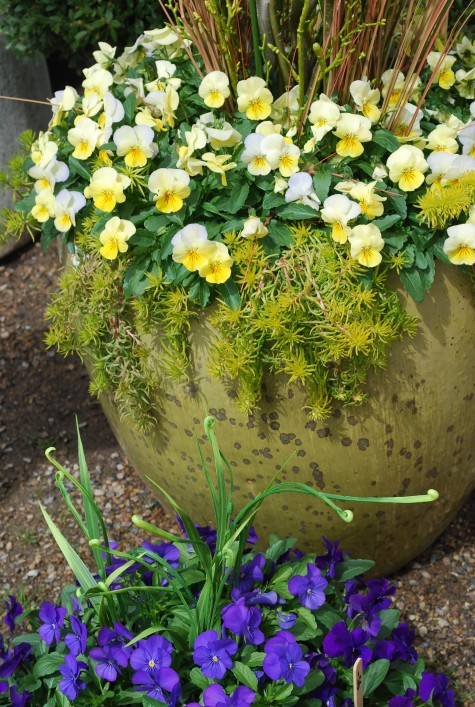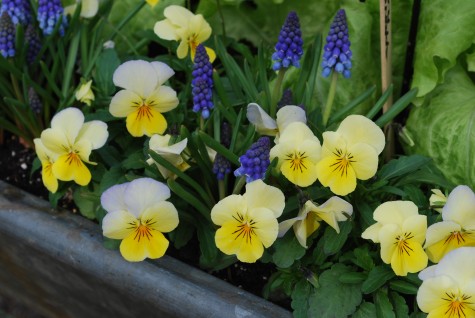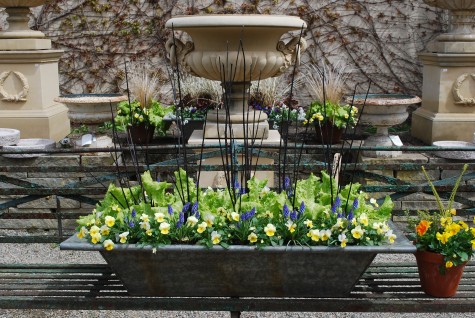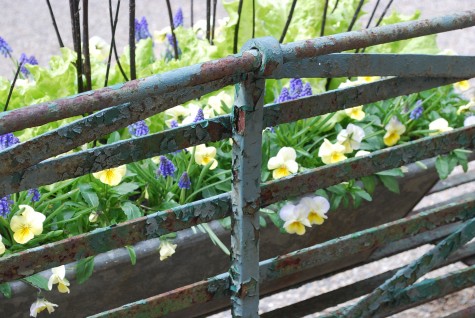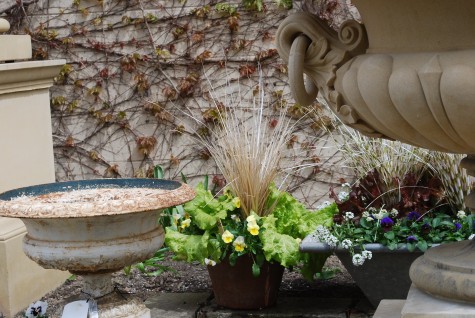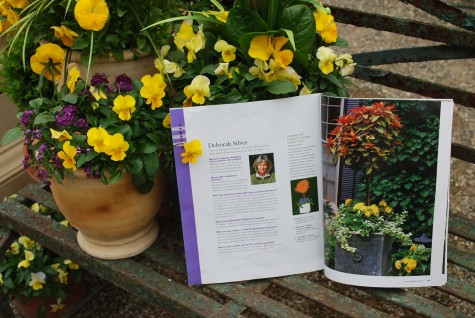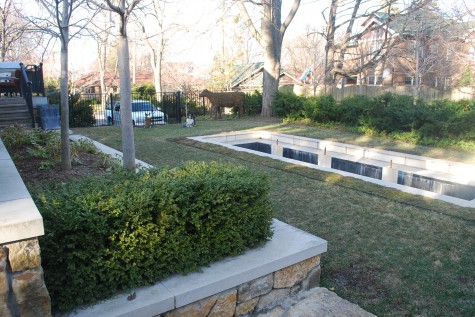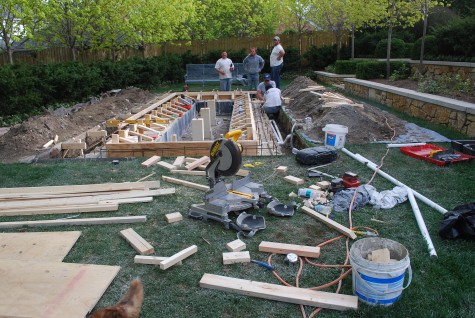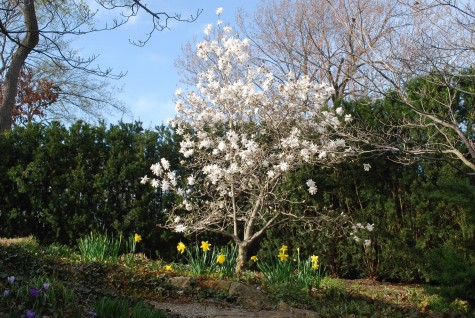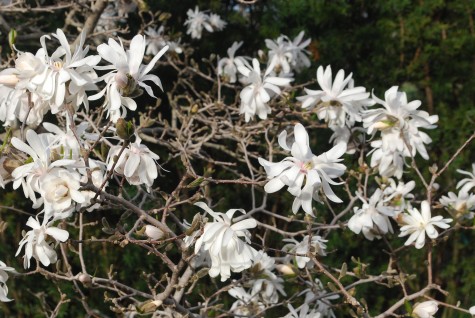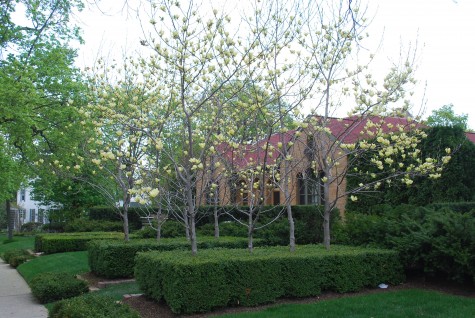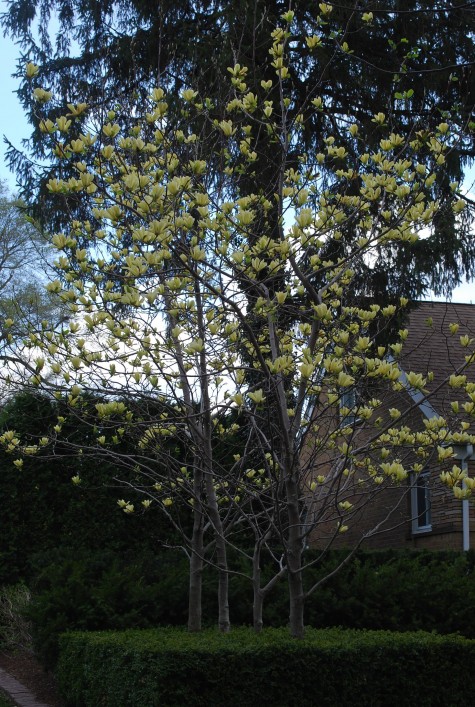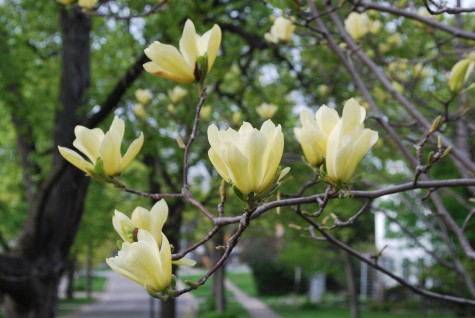Archives for April 2010
At A Glance: Glimpses of Spring
The Fine Gardening Container Issue
 Most gardeners like me are familiar with, and respect, Fine Gardening; it is indeed a fine publication featuring sound horticultural advice and great, beautifully detailed and illustrated ideas for gardeners. I myself was not aware that they published special issues-until I had occasion to meet their editor, Brandi Spade. She was in the area shooting photographs for an article for the magazine on container gardening with indoor tropicals last July, and called to see if she could take a look at some of my projects. Of course; I was thrilled she was interested. She spent the entire day, taking photographs, and talking gardens. Fast forward 8 months; my issue arrived a few days ago. It could not have been more perfectly timed; containers are on my mind. Who knew she remembered me? The lead article-50 inspiring ways to use your pots. Do not miss her letter from the editor about her life as a container gardener-it is terrific. Should you have a mind to pour over a print publication about container gardening-I recommend this issue.
Most gardeners like me are familiar with, and respect, Fine Gardening; it is indeed a fine publication featuring sound horticultural advice and great, beautifully detailed and illustrated ideas for gardeners. I myself was not aware that they published special issues-until I had occasion to meet their editor, Brandi Spade. She was in the area shooting photographs for an article for the magazine on container gardening with indoor tropicals last July, and called to see if she could take a look at some of my projects. Of course; I was thrilled she was interested. She spent the entire day, taking photographs, and talking gardens. Fast forward 8 months; my issue arrived a few days ago. It could not have been more perfectly timed; containers are on my mind. Who knew she remembered me? The lead article-50 inspiring ways to use your pots. Do not miss her letter from the editor about her life as a container gardener-it is terrific. Should you have a mind to pour over a print publication about container gardening-I recommend this issue.
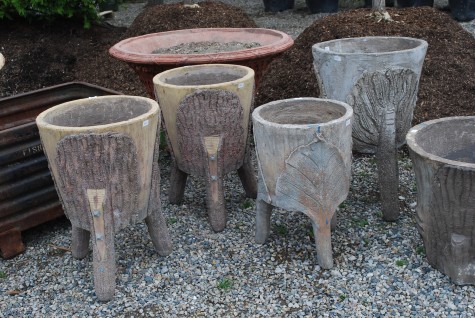 I plan to spend the next week or so addressing container plantings from my point of view-how to choose them, where to put them, how to insure container success-and ideas about how container gardens can enchant and satisfy. Whatever I write about has a way of making me sort through issues of my own; this is just one reason I so enjoy writing about gardening. I have a new annual planting season coming up that I plan to greet, meet, and forge new friends over. FG’s container issue covers everything from the relevant design tenets, to specific detail on plants; it is chock full o’ good advice and inspiration- sure to interest the heart of any container gardening afficianado. I admit I am inspired by what I read. As the time for decision making on pot gardens looms soon, I need to shift into drive right now. My starting point, inspired by the FG container issue- -50 inspired pots in which to grow your favorite plants. OK-just kidding. I promise not to make you roll your eyes and doze off as I detail 50 planters that makes my heart pound. I will comment on a few; I am counting on you to spread your wings. Some containers just ask for a green flag to be waved. These contemporary tripod faux bois planters-so fresh, woodsy and natural-what shade container gardener could resist them? If the idea of ferns, hardy or tropical, caladiums, club moss, baby tears-those tropicals that need steady shade to prosper outdoors-give these sassy tripod planters a look.
I plan to spend the next week or so addressing container plantings from my point of view-how to choose them, where to put them, how to insure container success-and ideas about how container gardens can enchant and satisfy. Whatever I write about has a way of making me sort through issues of my own; this is just one reason I so enjoy writing about gardening. I have a new annual planting season coming up that I plan to greet, meet, and forge new friends over. FG’s container issue covers everything from the relevant design tenets, to specific detail on plants; it is chock full o’ good advice and inspiration- sure to interest the heart of any container gardening afficianado. I admit I am inspired by what I read. As the time for decision making on pot gardens looms soon, I need to shift into drive right now. My starting point, inspired by the FG container issue- -50 inspired pots in which to grow your favorite plants. OK-just kidding. I promise not to make you roll your eyes and doze off as I detail 50 planters that makes my heart pound. I will comment on a few; I am counting on you to spread your wings. Some containers just ask for a green flag to be waved. These contemporary tripod faux bois planters-so fresh, woodsy and natural-what shade container gardener could resist them? If the idea of ferns, hardy or tropical, caladiums, club moss, baby tears-those tropicals that need steady shade to prosper outdoors-give these sassy tripod planters a look.
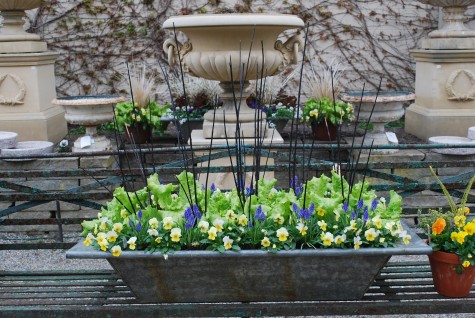 Who knows the original purpose of these galvanized v-shaped rectangles-should you know, please write me. Thanks! These look like giant baking tins. Vintage baking tins are just one of many possible objects that could conceivably hold soil and plants-what do you have in your shed, cupboard, or basement? Great containers are much about purpose and vision, and not so much about money- put some of this idea to work for you. This lettuce row, accented with grape hyacinth, violas and black willow-the hands down favorite no matter who comes through my door. The composition-Rob’s own.
Who knows the original purpose of these galvanized v-shaped rectangles-should you know, please write me. Thanks! These look like giant baking tins. Vintage baking tins are just one of many possible objects that could conceivably hold soil and plants-what do you have in your shed, cupboard, or basement? Great containers are much about purpose and vision, and not so much about money- put some of this idea to work for you. This lettuce row, accented with grape hyacinth, violas and black willow-the hands down favorite no matter who comes through my door. The composition-Rob’s own.
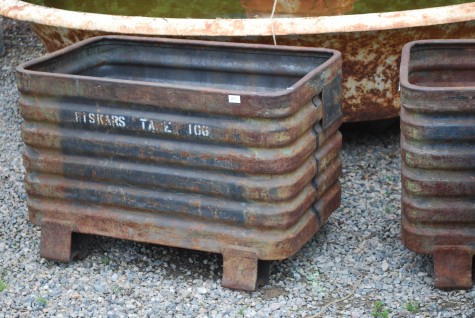 I only know the word Fiskars as it relates to scissors. But these chunky and texturally expressive industrial bins are just asking for a container garden of note; I had to buy them. People use containers of all kinds-to store, to bake, to ship, to organize, to stack. Container gardening-drop the gardening, and look at containers. Any good possibilities?
I only know the word Fiskars as it relates to scissors. But these chunky and texturally expressive industrial bins are just asking for a container garden of note; I had to buy them. People use containers of all kinds-to store, to bake, to ship, to organize, to stack. Container gardening-drop the gardening, and look at containers. Any good possibilities?
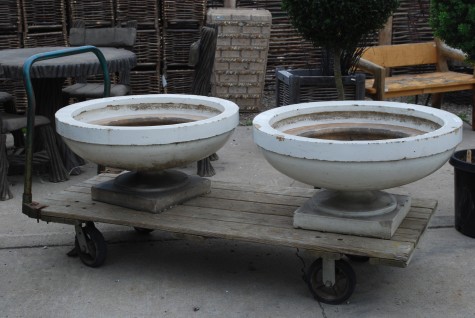 Regal and gorgeously proportioned-these glazed stoneware footed pots were manufactured in Chicago in the Arts and Crafts era. I could not specify a date, as they are unmarked-but I am guessing 1920-1940. They are unmistakeably early modern and midwest; I rarely see pots of this caliber. If the reproduction Frank Lloyd Wright planters seem chilly, and too widely distributed, these containers have an aura that could carry that same look with great style.
Regal and gorgeously proportioned-these glazed stoneware footed pots were manufactured in Chicago in the Arts and Crafts era. I could not specify a date, as they are unmarked-but I am guessing 1920-1940. They are unmistakeably early modern and midwest; I rarely see pots of this caliber. If the reproduction Frank Lloyd Wright planters seem chilly, and too widely distributed, these containers have an aura that could carry that same look with great style.
 This ancient-and I mean very ancient-lead cistern might hold water or plants, or sit distinctly empty and sculptural. Old lead never comes perfectly shaped. Lead collapses on itself; it is incredibly dense and weighty, and incredibly soft. If great age draws you, lead is a good choice. This cistern might have seen the reign of Henry the Eighth-no kidding. A container choice has everything to do with you; trust your eye.
This ancient-and I mean very ancient-lead cistern might hold water or plants, or sit distinctly empty and sculptural. Old lead never comes perfectly shaped. Lead collapses on itself; it is incredibly dense and weighty, and incredibly soft. If great age draws you, lead is a good choice. This cistern might have seen the reign of Henry the Eighth-no kidding. A container choice has everything to do with you; trust your eye.

No age is involved in these stainless steel vats salvaged from a chocolate factory. I do not fault them for this; they will shine, filled with water, and planted with white lotus. This is Rob’s idea-ok, I am fine to get in line behind it. A lively and expressive life for these bins- a new look for your container garden.
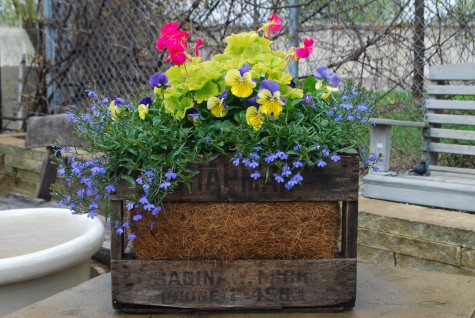
Any box can be lined with coir off the roll-we keep this in stock. By no means does every container need to come with a blue-bloom or blood pedigree. Some fabulous containers are just waiting for you to put your eye to them. Scour you garage, shed, kitchen, or favorite recycling venue. I am astonished and pleased at how much great style is fashioned from discarded bits. Should a container with great history be just the thing for you, Detroit Garden Works has a substantial collection. But if the cast off from the top shelf in the garage enchants you-stay your course.
The Fine Gardening container special issue featured a designer or design group from all our country’s regions. It felt so great to be selected to represent the midwest. Many thanks, Fine Gardening.
Trouble
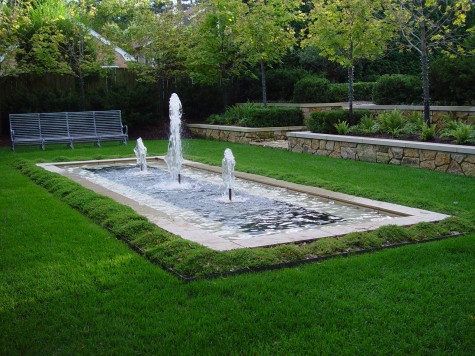
My fountain has given me so much pleasure; I would not want to have to do without water in my garden. As I have written before, I built it with some money my Mom left me. She disapproved of my habit of working long days and every day, such that her last birthday present to me was a set of beach towels. I think this body of water not only honors her wish for me, but proves her right. A little relaxation and reverie is a very good thing. For six serene years all was well, until this spring.
Barely visible in this picture-a white line some three inches below the bottom step of the pool. I have been in the landscape business long enough to know leaching concrete when I see it-I can only describe my feeling seeing this as pure and unadulterated dread. It appeared that the fountain had developed a crack-running all the way around the inside. I was especially taken aback, as we had had a particularly mild winter. What had happened?
The only way to find out-dig it up. It did take me a week to get to this point-the shock, I suppose. Who would be looking for a giant mess at the start of spring? Though the timing of this trouble was terrible, I did not have a choice. Buck was sure the pool would leak, and leak a lot. My crew excavated a 20 inch deep trench all the way around. I called Wes Gillette, from Gillette Brothers Pools-who else would I call? He and his company have an excellent reputation. They build pools and spas and fountains; they do repair.
 The first step was to fill the pool with water, and observe. I was holding my breath-as if holding my breath would make the pool hold water. Wes did not build this fountain-it was done by a stone mason. In retrospect, this was a bad decision. If you need something to first and foremost hold water, hire a professional pool contractor. That is what I would advise any client-what was my problem? In all fairness, said stone contractor did build other fountains that do not leak. I frankly would much rather the leaker to be mine, and not a client.
The first step was to fill the pool with water, and observe. I was holding my breath-as if holding my breath would make the pool hold water. Wes did not build this fountain-it was done by a stone mason. In retrospect, this was a bad decision. If you need something to first and foremost hold water, hire a professional pool contractor. That is what I would advise any client-what was my problem? In all fairness, said stone contractor did build other fountains that do not leak. I frankly would much rather the leaker to be mine, and not a client.
 It was not long before water was pouring through the wall into the trench. Wes’ brother Carter supervises and runs the repair division. He suspected that when the original concrete pour was finished, it was not level. A layer of mortar-3″ thick at one end, and 1/2 inch thick at the other, was applied to level the surface. A cold pour, they call this-and a non-bonding pour. No steel reinforcing. The mortar layer you see squishing out wider than the finish stone-this is called a hip. Imagine the frost coming out of and heaving up the ground-that frost took hold of that hip, lifted and cracked the entire top of the pool along that weak mortar joint. To put it mildly, this was not proper construction.
It was not long before water was pouring through the wall into the trench. Wes’ brother Carter supervises and runs the repair division. He suspected that when the original concrete pour was finished, it was not level. A layer of mortar-3″ thick at one end, and 1/2 inch thick at the other, was applied to level the surface. A cold pour, they call this-and a non-bonding pour. No steel reinforcing. The mortar layer you see squishing out wider than the finish stone-this is called a hip. Imagine the frost coming out of and heaving up the ground-that frost took hold of that hip, lifted and cracked the entire top of the pool along that weak mortar joint. To put it mildly, this was not proper construction.
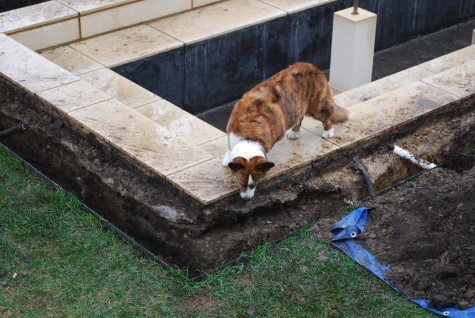 Though the corgis thought it was great fun to leap over the trench, I was heartsick. I do know that the force of frost action is considerable, and implacable. This is why in early April, when the frost is coming out of the ground, trucks above a certain weight are banned from using our roads. The frost laws help keep the roads from cracking and breaking up.
Though the corgis thought it was great fun to leap over the trench, I was heartsick. I do know that the force of frost action is considerable, and implacable. This is why in early April, when the frost is coming out of the ground, trucks above a certain weight are banned from using our roads. The frost laws help keep the roads from cracking and breaking up. 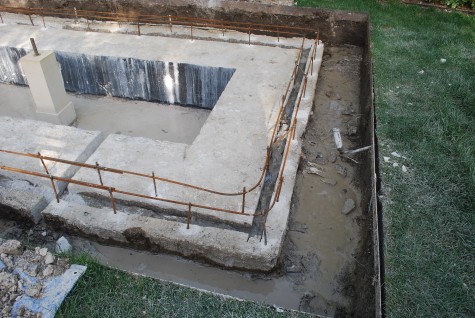
Mercifully, they did the demolition, hauled away all the debris, and prepared the lower surface to bond with the new one-in one day. This new concrete cookie would have no mortar-cream filling. They sawcut a trench in the original foundation, so the new concrete would interlock with the old. They inserted steel rebar into the existing concrete, and formed it tall enough to reinforce the layer that was to come. They covered the drains with rubber stoppers, so as to keep stone debris out of the filtration lines.
The next day, Carter and crew were there to build the new forms. Getting the forms level with the horizon-crucial to any vessel holding water. Almost none of the original stone survived the jack hammering that went on. Everything had to be removed down to the crack, so the pool step could be redone-properly, and professionally.
 It was an education to watch how they handled putting to right was was not done right. It is hard for anyone to consider redoing that which is already done; I have had lots of clients with plants placed improperly, or over irrigated, or sick; I have seen lots of just poor design. It is very hard to convince a client to put more good money to that which took a batch of perfectly good money in the first place. I understand this now, in a different way.
It was an education to watch how they handled putting to right was was not done right. It is hard for anyone to consider redoing that which is already done; I have had lots of clients with plants placed improperly, or over irrigated, or sick; I have seen lots of just poor design. It is very hard to convince a client to put more good money to that which took a batch of perfectly good money in the first place. I understand this now, in a different way.
 Yesterday, they took one wheelbarrow load after another to the back yard. By time I got home, the new concrete was poured. This will need to sit, to cure. Not that there will not be time; it will take 3 weeks to get the replacement stone cut and shipped.
Yesterday, they took one wheelbarrow load after another to the back yard. By time I got home, the new concrete was poured. This will need to sit, to cure. Not that there will not be time; it will take 3 weeks to get the replacement stone cut and shipped.

It could be that by the middle of May, my fountain will be back up and running; I have hope. Like replacing a furnace, or hot water heater, or air conditioning unit-a lot of money gets spent, and things just stay the same. This is very different than taking home a new pot, or sundial. Carter tells me the fountain will look exactly as it did; this part I like. This may be more than you ever wanted to know about concrete, frost and fountains, but thanks for listening to my story.
